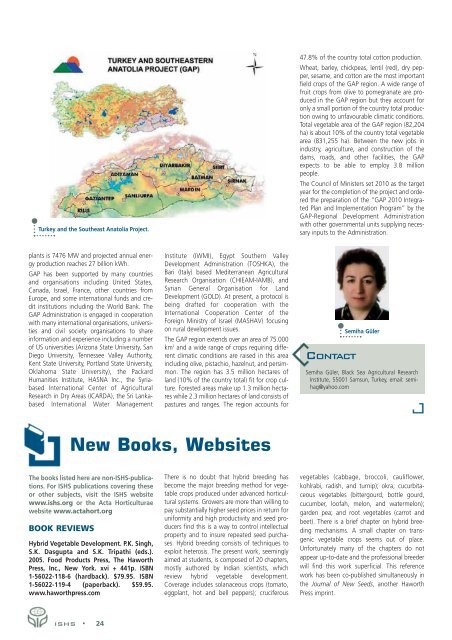The World Foliage Plant Industry - Acta Horticulturae
The World Foliage Plant Industry - Acta Horticulturae
The World Foliage Plant Industry - Acta Horticulturae
Create successful ePaper yourself
Turn your PDF publications into a flip-book with our unique Google optimized e-Paper software.
Turkey and the Southeast Anatolia Project.<br />
47.8% of the country total cotton production.<br />
Wheat, barley, chickpeas, lentil (red), dry pepper,<br />
sesame, and cotton are the most important<br />
field crops of the GAP region. A wide range of<br />
fruit crops from olive to pomegranate are produced<br />
in the GAP region but they account for<br />
only a small portion of the country total production<br />
owing to unfavourable climatic conditions.<br />
Total vegetable area of the GAP region (82,204<br />
ha) is about 10% of the country total vegetable<br />
area (831,255 ha). Between the new jobs in<br />
industry, agriculture, and construction of the<br />
dams, roads, and other facilities, the GAP<br />
expects to be able to employ 3.8 million<br />
people.<br />
<strong>The</strong> Council of Ministers set 2010 as the target<br />
year for the completion of the project and ordered<br />
the preparation of the “GAP 2010 Integrated<br />
Plan and Implementation Program” by the<br />
GAP-Regional Development Administration<br />
with other governmental units supplying necessary<br />
inputs to the Administration.<br />
plants is 7476 MW and projected annual energy<br />
production reaches 27 billion kWh.<br />
GAP has been supported by many countries<br />
and organisations including United States,<br />
Canada, Israel, France, other countries from<br />
Europe, and some international funds and credit<br />
institutions including the <strong>World</strong> Bank. <strong>The</strong><br />
GAP Administration is engaged in cooperation<br />
with many international organisations, universities<br />
and civil society organisations to share<br />
information and experience including a number<br />
of US universities (Arizona State University, San<br />
Diego University, Tennessee Valley Authority,<br />
Kent State University, Portland State University,<br />
Oklahoma State University), the Packard<br />
Humanities Institute, HASNA Inc., the Syriabased<br />
International Center of Agricultural<br />
Research in Dry Areas (ICARDA), the Sri Lankabased<br />
International Water Management<br />
Institute (IWMI), Egypt Southern Valley<br />
Development Administration (TOSHKA), the<br />
Bari (Italy) based Mediterranean Agricultural<br />
Research Organisation (CHIEAM-IAMB), and<br />
Syrian General Organisation for Land<br />
Development (GOLD). At present, a protocol is<br />
being drafted for cooperation with the<br />
International Cooperation Center of the<br />
Foreign Ministry of Israel (MASHAV) focusing<br />
on rural development issues.<br />
<strong>The</strong> GAP region extends over an area of 75.000<br />
km 2 and a wide range of crops requiring different<br />
climatic conditions are raised in this area<br />
including olive, pistachio, hazelnut, and persimmon.<br />
<strong>The</strong> region has 3.5 million hectares of<br />
land (10% of the country total) fit for crop culture.<br />
Forested areas make up 1.3 million hectares<br />
while 2.3 million hectares of land consists of<br />
pastures and ranges. <strong>The</strong> region accounts for<br />
CONTACT<br />
Semiha Güler<br />
Semiha Güler, Black Sea Agricultural Research<br />
Institute, 55001 Samsun, Turkey, email: semihag@yahoo.com<br />
New Books, Websites<br />
<strong>The</strong> books listed here are non-ISHS-publications.<br />
For ISHS publications covering these<br />
or other subjects, visit the ISHS website<br />
www.ishs.org or the <strong>Acta</strong> <strong>Horticulturae</strong><br />
website www.actahort.org<br />
BOOK REVIEWS<br />
Hybrid Vegetable Development. P.K. Singh,<br />
S.K. Dasgupta and S.K. Tripathi (eds.).<br />
2005. Food Products Press, <strong>The</strong> Haworth<br />
Press, Inc., New York. xvi + 441p. ISBN<br />
1-56022-118-6 (hardback). $79.95. ISBN<br />
1-56022-119-4 (paperback). $59.95.<br />
www.haworthpress.com<br />
<strong>The</strong>re is no doubt that hybrid breeding has<br />
become the major breeding method for vegetable<br />
crops produced under advanced horticultural<br />
systems. Growers are more than willing to<br />
pay substantially higher seed prices in return for<br />
uniformity and high productivity and seed producers<br />
find this is a way to control intellectual<br />
property and to insure repeated seed purchases.<br />
Hybrid breeding consists of techniques to<br />
exploit heterosis. <strong>The</strong> present work, seemingly<br />
aimed at students, is composed of 20 chapters,<br />
mostly authored by Indian scientists, which<br />
review hybrid vegetable development.<br />
Coverage includes solanaceous crops (tomato,<br />
eggplant, hot and bell peppers); cruciferous<br />
vegetables (cabbage, broccoli, cauliflower,<br />
kohlrabi, radish, and turnip); okra; cucurbitaceous<br />
vegetables (bittergourd, bottle gourd,<br />
cucumber, loofah, melon, and watermelon);<br />
garden pea; and root vegetables (carrot and<br />
beet). <strong>The</strong>re is a brief chapter on hybrid breeding<br />
mechanisms. A small chapter on transgenic<br />
vegetable crops seems out of place.<br />
Unfortunately many of the chapters do not<br />
appear up-to-date and the professional breeder<br />
will find this work superficial. This reference<br />
work has been co-published simultaneously in<br />
the Journal of New Seeds, another Haworth<br />
Press imprint.<br />
ISHS • 24

















